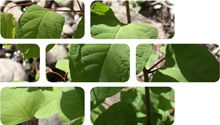
Japanese Knotweed 20 02 01
Japanese Knotweed is a tall, vigorous ornamental plant that is green in colour with shovel shaped leaves, a bamboo-like stem and produces white flowers around September and October. It is a non-native invasive species of plant which out-competes native plants and animals. It is not hazardous, although materials containing knotweed treated with certain herbicides may be classified as hazardous waste. Giant Knotweed and the Hybrid Knotweed should be treated in the same manner.
Usage & Probable Locations
Japanese Knotweed was introduced to Britain in the 19th Century and used for ornamental purposes in gardens and parks which has spread widely along rivers, canals, roadsides, hedgerows, parks, gardens, railway sidings and derelict sites. Its rapid growth can damage buildings, pavements, roads, underground services and flood defences. It can cover large areas and left uncontrolled may have a forest like appearance. It can also be found in excavated materials including soils and top soils that may also have been imported to site.
Personal Protective Equipment
PPE requirements indicated are for guidance purposes only. DRIDS has identified the PPE that is mandatory on all demolition projects and ones that may be required subject to site specific Risk Assessment & Method Statement (RAMS). Hover over the icon to determine the types of PPE required for the removal of this material.
Removal, Segregation & Storage
It is an offence under the Wildlife and Countryside act 1981 to plant or cause Japanese Knotweed to spread. A Japanese Knotweed Management Plan should be defined and implemented from the outset, identifying which materials are treated with herbicides, burnt, bunded, buried, protected by a root barrier membrane or disposed to an authorised landfill. Soil infested with knotweed rhizomes and/or cut stems should be treated on site with a choice of herbicides. These treated materials can be reused for localised landscaping that can easily be treated if it reoccurs. It should only be sent to an authorised landfill site as a last resort.
Tools
Fixtures, Fittings & Connections
Health & Safety
Subject to task-specific Risk Assessment & Method Statement (RAMS). Use correct protective equipment when working with plants, contaminated materials or herbicides. Wear gloves when handling contaminated materials to prevent cuts, abrasion or contamination. Use eye protection when using tools or treatments. Only qualified operators should use herbicides. Avoid any transfer of plant cuttings or rhizomes. Ensure all vehicles are power washed before leaving the contaminated area. Use appropriate equipment, tools and treatments determined by RAMS. Store in appropriate containers for disposal.










